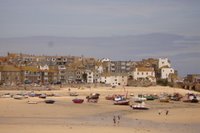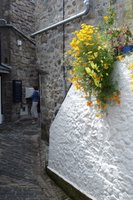 It was pouring rain when we left our friends Keith and Catherine's house and headed for Cornwall, and it didn't clear until after lunch in the tourist mecca of St. Ives on Cornwall's north coast. Thus we established our pattern for Cornwall: puttering about in the morning, followed by a confusing search for the sea cliff du jour in the afternoon, leaving time for only a pitch or two.
It was pouring rain when we left our friends Keith and Catherine's house and headed for Cornwall, and it didn't clear until after lunch in the tourist mecca of St. Ives on Cornwall's north coast. Thus we established our pattern for Cornwall: puttering about in the morning, followed by a confusing search for the sea cliff du jour in the afternoon, leaving time for only a pitch or two.
 Well, we were on vacation. What with the stunning coastal scenery and charming villages to explore, we weren't really in much of a hurry.
Well, we were on vacation. What with the stunning coastal scenery and charming villages to explore, we weren't really in much of a hurry.
The weather had turned perfect, making me 2 for 2 for T-shirt weather in Cornwall. In 1987, after a cold, dreary winter in London, I spent four days in North Devon and Cornwall over Easter with a crew of Brits who worked at the same Alpine Sports shop that had agreed to employ me for a few months. (Hint to potential floor workers in British climbing shops: When someone asks you to "Show me your pits," he's not being rude. "Pits" is slang for sleeping bags in the UK. Or at least it was in 1987.)  The weather was gorgeous that spring, too, and the sun-starved Brits fried themselves the color of Maine lobsters. We had spent one day at the granite cliff of Bosigran, and so Chris and I steered there first, as I remembered it being very pleasant (check) and non-tidal (check, at least for the routes we were after), and I felt relatively confident of finding it (check). After all the rain, we only had time for one route, but it was a beauty: Anvil Chorus (HVS 4c, or roughly 5.9).
The weather was gorgeous that spring, too, and the sun-starved Brits fried themselves the color of Maine lobsters. We had spent one day at the granite cliff of Bosigran, and so Chris and I steered there first, as I remembered it being very pleasant (check) and non-tidal (check, at least for the routes we were after), and I felt relatively confident of finding it (check). After all the rain, we only had time for one route, but it was a beauty: Anvil Chorus (HVS 4c, or roughly 5.9).  The first pitch was fairly nondescript, but the second was a corker, with a gorgeous finger and hand crack leading to a frightening-looking but easy traverse that lulled you into a false sense of confidence for the desperate mantel at the end. I could go back to Bosigran again and again. Beautiful place.
The first pitch was fairly nondescript, but the second was a corker, with a gorgeous finger and hand crack leading to a frightening-looking but easy traverse that lulled you into a false sense of confidence for the desperate mantel at the end. I could go back to Bosigran again and again. Beautiful place.
Next day we puttered about looking at various villages and neolithic ruins, and then decided it was time to go climbing. After a false start at one incredibly windy crag, we ended up on more granite at Carn Barra. As with most of these cliffs, there are no anchors at the top, and it's really hard to figure out where you are. We spent at least an hour trying to locate the tops of the climbs we aimed to do, and then building a good anchor and lowering into the unknown. After a gander at our chosen route from the bottom, I decided to toprope. The climb was superb and supposedly E3 6a (well-protected 5.11), but while the "5.11" felt right, the "well-protected" seemed to be missing. To start, you stood atop a boulder about six feet off the deck, then did a hard boulder problem over a chasm until you were about 15 feet up, where you could place your first, possibly adequate protection. And then you began the crux. Hence the toprope. But it was a great route, and afterward I led a superb 5.10 line and watched a seal fishing with the incoming tide. The rapidly incoming tide. Our third route was hurried. I've often wished slow partners could have a time clock enforced while they were climbing. On sea cliffs, the tide is a stern enforcer.
Further puttering the next day stalled us in Cornwall until noon, and thus we didn't make it to North Devon until midafternoon. This day's crag was Lower Sharpnose Point, an extraordinary trio of 100-foot-high fins that project toward the sea.  At low tide you can walk around the base of the fins, giving access to dead vertical cliffs (overhanging for the big, bad routes). I have no idea what kind of rock this was, but like many sea-cliff routes the first few feet involved smearing on barnacles. We were tight for time and a bit fried after five days in a row of exploring and climbing, and neither of us was in the mood for a big challenge. I chose the easiest route I could find and raced up it. There was some doubt (which I kept to myself) about how we would escape from the top, but the answer was a horizontal sidewalk in the sky, about six feet wide, 100 feet long, and plunging to either side. We kept the rope on.
At low tide you can walk around the base of the fins, giving access to dead vertical cliffs (overhanging for the big, bad routes). I have no idea what kind of rock this was, but like many sea-cliff routes the first few feet involved smearing on barnacles. We were tight for time and a bit fried after five days in a row of exploring and climbing, and neither of us was in the mood for a big challenge. I chose the easiest route I could find and raced up it. There was some doubt (which I kept to myself) about how we would escape from the top, but the answer was a horizontal sidewalk in the sky, about six feet wide, 100 feet long, and plunging to either side. We kept the rope on.  Although our route was so lowly it wasn't even described in our "selected climbs" guide, it was still pretty good, and Lower Sharpnose is one of the most amazing crags I've ever seen. Yet another must-return-someday cliff.
Although our route was so lowly it wasn't even described in our "selected climbs" guide, it was still pretty good, and Lower Sharpnose is one of the most amazing crags I've ever seen. Yet another must-return-someday cliff.
Thursday, July 20, 2006
My British Vacation III: On to Cornwall
Posted by
Dougald MacDonald
at
9:43 PM
![]()
![]()
Subscribe to:
Post Comments (Atom)








1 comment:
Great trip report, thanks!
-Brian Cabe
Post a Comment